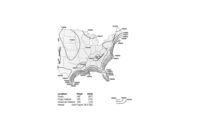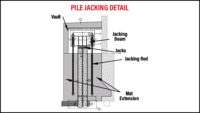American Society of Civil Engineers 2010 Wind-Load Design Standard is Under Fire
The American Society of Civil Engineers has decided that emergency changes to wind-load provisions in ASCE's 2010 building design standard are not needed. ASCE recently reviewed the provisions, prompted by a red flag raised by structural engineer-researcher Emil Simiu, who says the wind standard is flawed and needlessly complex.
 |
| SIMIU |
To aid in its decision, ASCE canvassed structural and wind experts regarding Simiu's concerns. “We are of the collective opinion that none of the issues warrant immediate action,” says Ronald A. Cook, the ASCE/SEI 7-10 wind subcommittee chair and a professor of civil engineering at the University of Florida, Gainesville.
Simiu is not the only one who takes issue with the 130-page wind section, which ASCE describes as an easier-to-use version of its 60-page, 2005 predecessor. Wind provisions are “way too complicated for practicing engineers,” says Clifford W. Schwinger, a vice president of structural consultant Harman Group Inc., King of Prussia, Pa. “I argue that, in some respects, the public may be less safe with these ever-increasingly complex codes.”
Timothy A. Reinhold, a subcommittee member and chief engineer for the Insurance Institute for Business & Home Safety, Tampa, says the standard is longer, in part, because it contains first-time guidance on wind loads for special conditions, such as rooftop solar panels. “For fairly simple buildings, there are about six [relevant] pages,” says Reinhold. But it may take users “some time, at first, to figure out which six pages to use,” he adds.
 |
| COOK |
Specifically, Simiu objects to insufficiently differentiated wind-speed maps for non-hurricane zones and to wind-pressure coefficients that are too low for some building types. Underestimated wind speeds or coefficients can result in unconservative design wind effects, he says.
James R. Harris, founder of J.R. Harris & Co., Denver, and chair of the ASCE/SEI 7-10 main committee, “strongly disagrees” with several of Simiu's concerns, including the wind-speed maps. “The spatial averaging procedure is valid,” Harris says. “It is a useful tool for removing the effects of some uncontrollable natural and [human] errors in data sampling.”
But Harris concedes that some provisions are “less clear, less user-friendly and more complex than would be desirable, in spite of our collective best efforts.”
Simiu also takes issue with new, simpler design methods. The methods can yield a 30% difference in design results for the same structure, he says.
I have said for a long time that all the codes are getting too complicated and confusing for practicing engineers to use. Owners are not interested in paying for the time necessary to ...
Many years ago I was told by a top member of a BOCA committee that I should remember that the code authorities have to modify the code to sell more copies and generate income! Think about that. If the code changes, how many copies have to be sold to replace the old ones? Do we really need revisions every three years? I have a letter of advice from Dr. Ellingwood that has been hanging on my office bulletin board for almost 30 years and we have followed that advice. It is as good today as it was then. I agree with him that we should simplify the system. We need not change the code for every academic paper written about wind, snow or earthquake.
Although I am not a expert on structural wind loading, for light poles I would use<br/>a size or two stronger pole than the standards required because I felt uncomfortable<br/>about the...
a size or two stronger pole than the standards required because I felt uncomfortable
about the prohibitions against hanging banners on the pole, and because it was
obvious,at least to me, that the size of the handhole was really too small for ordinarily
sized hands to work easily splicing wiring inside the pole. So I got the impression the poles were really being designed to a bare minimum and tried to compensate.
What one engineer said about specifications deserves to be memoralized
" But specifications made by committees are impersonal,and they
dull because they are repositories of what is stale. Some units of
the committee are watch dogs assembled to see that nothing old
is discarded and nothing new creeps in, others are disguised
commercials who are there to maintain what is good for trade.
If there is a member, well - informed and pugnacious who asks
for reasons why, the meeting will be lively ; but he will be subdued
by vote if not by explanation or argument. The committee specification
is not informative or adventurous, it is not intended to be. People
who have had no experience in making them are likely to think there
is an element of gospel truth about a specification. If it is well-worn,
there is a gray- haired sanctity about it that deludes even professors.
The homage is usually misplaced. Specifications are often compromises
between competing commercial interests mixed in with tough prejudice
from a bygone generation. "
Harry Brearly, "Talks about Steelmaking" ,1946
Perhaps the best example of defective specifications is the United States Income
Tax Code. The income tax corrected a gross evil, the fact that the well off paid no
taxes, while the rest paid excessive taxes because the necessities they consumed
were taxed and high tariffs kept manufacturers from foreign competition.
However the income tax was unconstitutional so the 16th amendment was passed
making the personnel income tax legal and at the same time imposing a tax on
corporate profits seen technically as an excise tax and therefore legal. The
corporate income tax and the personnel income tax had deductions from the
beginning and have remained uncoordinated from the beginning 98 years ago.
As John Steele Gordon in his op ed piece in the 27 Sept Wall Street Journal
remarks "One original sin was the separation of the corporate and personal tax,
giving lawyers,accountants and the wealthy a chance to game the system"
Engineering specifications too have long been game for system gaming, but I
wonder if we are now inducing system induced failures by making specifications
increasingly complex while at the same time there is increasing evidence that
engineers are increasingly being ill schooled and hence unable to distinguish
the wheat from the chaff in specifications. Unlike the Income Tax, Engineering
Specifications have self correcting mechanisms,accidents, but it should not
take a Deepwater Horizon or a 3 mile island meltdown to realize boilers should
have pressure gauges.
I authored the 5:37 PM comment, and believe with 5:17 PM that we need not change the code<br/>for every academic paper written about wind, snow or earthquake.<br/><br/>As the Income Tax...
for every academic paper written about wind, snow or earthquake.
As the Income Tax Code and Engineering History has shown, we need to junk
the codes and start fresh.
The 3 year code cycle is, unfortunately, not about public safety as much as it is about justification for non-practicing engineers to impart their research wisdom, while maintaining the...
As a practicing engineer, I heartily agree with SImiu. I cannot state one way or the other an opinion about the maps, but the standard is far more complex than it needs to be - with to...
I am not a dim bulb - I have an SE, 20 years experience. It is just that I do a lot of different kinds of structures, and don't have the ability to specialize in just one field - for instance, metal buildings. In fact, it is my understanding that much of the added complexity in the last couple of code cycles (regarding wind) has been to satisfy the metal building industry, so that they can take every last ounce out of their structures - of course, using proprietary computer programs.
Enough is enough to the codes.
I know a brilliant engineer (who shall go un-named, a Principal at a firm that I used to work for) who is a member of 2 (count -em, two) ASCE Committees - who still uses the 9th Edition AISC for Steel. Not going to LRFD.
Same with the wind load provisions.
Charles Waugh, S.E.
Bellingham, WA
I do not think that some of the critics have actually read the provisions and made a comparison with previous versions. Yes, it is larger. But the additions do not make it more compli...
I detect an anti intellectual bias in the proceeding 2 comments. Given a choice<br/>between what an academic believes and how the typical engineer practices his <br/>art there is no com...
between what an academic believes and how the typical engineer practices his
art there is no comparison. This is not to say that academics can't be wrong but
an academic 's stated purpose is to get as close to the "truth" and understanding as possible while the most of the world is just self serving. My experience as an engineer tells me that so called "experience of the practical man" can and is overated
when good theory developed by the academic mind is available.
I believe that if only academics were given the job of writing the wind load provisions
of the building code it would be far clearer,informative and easier to use.
For example,it should not take a brilliant academic mind to note that the profusion
of tables in this day and age serves only to fit the bulky code as a doorstop, or that
it should not take a brilliant academic mind to draw attention to the fact that according to the code drastic changes occur as wind speed changes from 59 to
61 miles per hour.
Given the choice between having a code making panel composed of a congeries of vendors pushing their products, a congeries of "practical" engineers, the "legacy"
engineers,pushing their "experience", and academics who are the only progressives,
who could not vote for the progressives?
In my engineering life, so called practical engineers have let me down, vendors have
let me down, it is to academics I am indebted to.
To Anonymous 5:10. <br/><br/>To think that without practicing engineers, academics could produce a clearer code is mind boggling. Go pick up the Journal of Structural Engineering and ...
To think that without practicing engineers, academics could produce a clearer code is mind boggling. Go pick up the Journal of Structural Engineering and read how practical the research is presented.
To Anonymous 9: 38<br/><br/>The idea that without the aid of practicing engineers, academics may produce a clearer code may be mind boggling, but citing the non relevance or worse of ac...
The idea that without the aid of practicing engineers, academics may produce a clearer code may be mind boggling, but citing the non relevance or worse of academic papers, does not prove this can't happen.
It is not the non-relevance, it is the method of writing. Even for a practical topic, academics do not understand what is and is not relevant to a practicing engineer.
Academics don't necessarily have to write so engineers can't understand them nor are their writings necessarily non relevant to the practicing engineer. For instance E. Simui has writte...
As long ago as pre 1934 engineers were designing low rise buildings that were being damaged by wind as noted in the 1934 textbook "Structural Design in Steel" by Professor Thomas Clark Shedd.
The "brilliant" engineer who still uses a far less realistic model for his designing in steel would not be allowed to design government funded railroad bridges.<br/><br/>It is unfortuna...
It is unfortunate but true that American structural engineers have to be forced into adopting progressive design methods; and when they do so it is not because they want to but because it is seemingly cheaper. Engineers have to pay attention to economy but as the failure of engineers to heed what both the wind and academic engineers are telling them, their failure to adopt more realistic models of the world, together with penny pinching is the cause of much grief.






